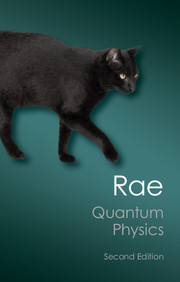Book contents
- Frontmatter
- Dedication
- Contents
- Preface to the first edition
- Preface to the second edition
- 1 Quantum physics
- 2 Which way are the photons pointing?
- 3 What can be hidden in a pair of photons?
- 4 Wonderful Copenhagen?
- 5 Is it all in the mind?
- 6 Many worlds
- 7 Is it a matter of size?
- 8 Backwards and forwards
- 9 Only one way forward?
- 10 Can we be consistent?
- 11 Illusion or reality?
- Further reading
- Index
5 - Is it all in the mind?
Published online by Cambridge University Press: 05 February 2014
- Frontmatter
- Dedication
- Contents
- Preface to the first edition
- Preface to the second edition
- 1 Quantum physics
- 2 Which way are the photons pointing?
- 3 What can be hidden in a pair of photons?
- 4 Wonderful Copenhagen?
- 5 Is it all in the mind?
- 6 Many worlds
- 7 Is it a matter of size?
- 8 Backwards and forwards
- 9 Only one way forward?
- 10 Can we be consistent?
- 11 Illusion or reality?
- Further reading
- Index
Summary
In the last chapter we saw how the measurement problem in quantum theory arises when we try to treat the measurement apparatus as a quantum system. We need more apparatus to measure which state the first apparatus is in, and we have a measurement chain that seems to go on indefinitely. There is, however, one place where this apparently infinite sequence certainly seems to end and that is when the information reaches us. We know from experience that when we look at the photon detector we see that either it has recorded the passage of a photon or it hasn't. When we open the box and look at the cat either it is dead or it is alive; we never see it in the state of suspended animation that quantum physics alleges it should be in until its state is measured. It might follow, therefore, that human beings should be looked on as the ultimate measuring apparatus. If so, what aspect of human beings is it that gives them this apparently unique quality? It is this question and its implications that form the subject of the present chapter.
Let us examine more closely what goes on when a human being observes the quantum state of a system. We return to the set-up described in the last chapter, where a 45° photon passes through a polarisation analyser that moves a pointer to one of two positions (H or V) depending on whether the photon is horizontally or vertically polarised. At least that is what would happen if the analyser and pointer behaved as a measuring apparatus. If however we treat them as part of the quantum system, the pointer is placed in a superposition of being at H and at V until its state is measured. We now add a human observer who looks at the pointer (it would be possible to imagine the observer using one of his other senses, for example hearing a particular sound caused by a change in the pointer’s position, but it is clearer if we think of a visual observation).
- Type
- Chapter
- Information
- Quantum PhysicsIllusion or Reality?, pp. 62 - 74Publisher: Cambridge University PressPrint publication year: 2012



